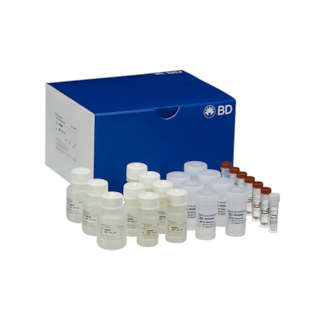-
Your selected country is
Middle East / Africa
- Change country/language
Old Browser
This page has been recently translated and is available in French now.
Looks like you're visiting us from {countryName}.
Would you like to stay on the current country site or be switched to your country?


Oligo Mouse Anti-Human CD226
Regulatory Status Legend
Any use of products other than the permitted use without the express written authorization of Becton, Dickinson and Company is strictly prohibited.
Preparation And Storage
Recommended Assay Procedures
Put all BD® AbSeq Reagents to be pooled into a Latch Rack for 500 µL Tubes (Thermo Fisher Scientific Cat. No. 4900). Arrange the tubes so that they can be easily uncapped and re-capped with an 8-Channel Screw Cap Tube Capper (Thermo Fisher Scientific Cat. No. 4105MAT) and the reagents aliquoted with a multi-channel pipette.
BD® AbSeq tubes should be centrifuged for ≥ 30 seconds at 400 × g to ensure removal of any content in the cap/tube threads prior to the first opening.
Product Notices
- This reagent has been pre-diluted for use at the recommended volume per test. Typical use is 2 µl for 1 × 10^6 cells in a 200-µl staining reaction.
- The production process underwent stringent testing and validation to assure that it generates a high-quality conjugate with consistent performance and specific binding activity. However, verification testing has not been performed on all conjugate lots.
- Please refer to bd.com/genomics-resources for technical protocols.
- Caution: Sodium azide yields highly toxic hydrazoic acid under acidic conditions. Dilute azide compounds in running water before discarding to avoid accumulation of potentially explosive deposits in plumbing.
- Source of all serum proteins is from USDA inspected abattoirs located in the United States.
- Illumina is a trademark of Illumina, Inc.
- Please refer to http://regdocs.bd.com to access safety data sheets (SDS).
- For U.S. patents that may apply, see bd.com/patents.
Companion Products





The DX11 monoclonal antibody specifically binds to CD226 which is also known as DNAX accessory molecule-1 (DNAM-1), Platelet and T cell activation antigen 1 (PTA1), or T lineage-specific activation antigen 1 antigen (TLiSA1). CD226 is a 65 kDa type 1 transmembrane glycoprotein consisting of 318 amino acid residues including two Ig-like domains. CD226 is expressed on the majority of T cells, NK cells, monocytes, platelets, and a subset of B cells, but not on erythrocytes. It is also present on a subset of thymocytes coexpressing high density surface CD3. CD226 is not present on normal fibroblast cell lines or tumor cell lines of epithelial or neuronal origins. CD226 is a tyrosine phosphorylated, signal-transducing molecule which participates in primary adhesion during cytotoxic T lymphocyte (CTL)- or NK cell-mediated cytotoxicity. The DX11 antibody inhibits T- and NK cell-mediated cytotoxicity against a variety of tumor cell targets, and blocks cytokine production by alloantigen-specific T cells.
Development References (4)
-
Lanier LL, Shibuya A, Burns G. CD226 (DNAM-1, PTA1, Tlisa). In: Mason D. David Mason .. et al., ed. Leucocyte typing VII : white cell differentiation antigens : proceedings of the Seventh International Workshop and Conference held in Harrogate, United Kingdom. Oxford: Oxford University Press; 2002:921-922.
-
Shibuya A, Campbell D, Hannum C, et al. DNAM-1, a novel adhesion molecule involved in the cytolytic function of T lymphocytes. Immunity. 1996; 4(6):573-581. (Immunogen: Bioassay, Blocking, Flow cytometry, Functional assay, Immunoaffinity chromatography, Inhibition, Western blot). View Reference
-
Shibuya A, Lanier LL, Phillips JH. Protein kinase C is involved in the regulation of both signaling and adhesion mediated by DNAX accessory molecule-1 receptor. J Immunol. 1998; 161(4):1671-1676. (Clone-specific: Bioassay, Blocking, Cytotoxicity, Flow cytometry, Functional assay, Immunoprecipitation). View Reference
-
Zola H, Swart B, Boumsell L, Mason DY. Human Leucocyte Differentiation Antigen nomenclature: update on CD nomenclature. Report of IUIS/WHO Subcommittee.. J Immunol Methods. 2003; 275(1-2):1-8. (Clone-specific: Flow cytometry). View Reference
Please refer to Support Documents for Quality Certificates
Global - Refer to manufacturer's instructions for use and related User Manuals and Technical data sheets before using this products as described
Comparisons, where applicable, are made against older BD Technology, manual methods or are general performance claims. Comparisons are not made against non-BD technologies, unless otherwise noted.
For Research Use Only. Not for use in diagnostic or therapeutic procedures.
Report a Site Issue
This form is intended to help us improve our website experience. For other support, please visit our Contact Us page.